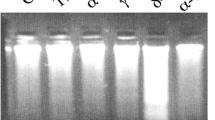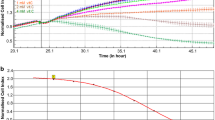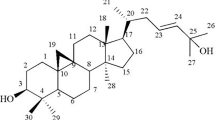Abstract
γ-Tocotrienol, a member of the vitamin E family of compounds, induces apoptosis in a variety of cancer cell types. However, previous studies have clearly demonstrated that γ-tocotrienol-induced apoptosis in neoplastic mouse +SA mammary epithelial cells is not mediated through mitochondrial stress or death receptor apoptotic signaling. Therefore, studies were conducted to determine the role of endoplasmic reticulum (ER) stress in mediating γ-tocotrienol-induced apoptosis in +SA mammary tumor cells. Treatment with 15–40 μM γ-tocotrienol induced +SA cell death in a dose-responsive manner, and these effects were associated with a corresponding increase in poly (ADP-ribose) polymerase (PARP)-cleavage and activation of protein kinase-like endoplasmic reticulum kinase/eukaryotic translational initiation factor/activating transcription factor 4 (PERK/eIF2α/ATF-4) pathway, a marker of ER stress response. These treatments also caused a large increase in C/EBP homologous protein (CHOP) levels, a key component of ER stress mediated apoptosis that increases expression of tribbles 3 (TRB3). Knockdown of CHOP by specific siRNAs attenuated γ-tocotrienol-induced PARP-cleavage, CHOP and TRB3 expression. γ-Tocotrienol treatment also reduced full-length caspase-12 levels, an indication of caspase-12 cleavage and activation. Intracellular levels of 3-hydroxy-3-methylglutaryl-coenzyme A (HMGCoA) reductase, an ER-transmembrane enzyme catalyzing the synthesis of mevalonate, decreased following γ-tocotrienol treatment, but combined treatment with mevalonate did not reverse γ-tocotrienol-induced apoptosis, suggesting that a decrease in HMGCoA reductase activity is not required for γ-tocotrienol induced apoptosis. These results demonstrate that ER stress apoptotic signaling is associated with γ-tocotrienol-induced apoptosis in +SA mammary tumor cells.








Similar content being viewed by others
References
Yap WN, Chang PN, Han HY, Lee DT, Ling MT et al (2008) Gamma-tocotrienol suppresses prostate cancer cell proliferation and invasion through multiple-signalling pathways. Br J Cancer 99:1832–1841. doi:10.1038/sj.bjc.6604763
Wada S, Satomi Y, Murakoshi M, Noguchi N, Yoshikawa T et al (2005) Tumor suppressive effects of tocotrienol in vivo and in vitro. Cancer Lett 229:181–191. doi:10.1016/j.canlet.2005.06.036
Sun W, Xu W, Liu H, Liu J, Wang Q et al (2009) Gamma-tocotrienol induces mitochondria-mediated apoptosis in human gastric adenocarcinoma SGC-7901 cells. J Nutr Biochem 20:276–284. doi:10.1016/j.jnutbio.2008.03.003
Sen CK, Khanna S, Roy S (2006) Tocotrienols: vitamin E beyond tocopherols. Life Sci 78:2088–2098. doi:10.1016/j.lfs.2005.12.001
Sylvester PW (2007) Vitamin E and apoptosis. Vitam Horm 76:329–356. doi:10.1016/S0083-6729(07)76012-0
McIntyre BS, Briski KP, Gapor A, Sylvester PW (2000) Antiproliferative and apoptotic effects of tocopherols and tocotrienols on preneoplastic and neoplastic mouse mammary epithelial cells. Proc Soc Exp Biol Med 224:292–301
McIntyre BS, Briski KP, Tirmenstein MA, Fariss MW, Gapor A et al (2000) Antiproliferative and apoptotic effects of tocopherols and tocotrienols on normal mouse mammary epithelial cells. Lipids 35:171–180
Shah S, Gapor A, Sylvester PW (2003) Role of caspase-8 activation in mediating vitamin E-induced apoptosis in murine mammary cancer cells. Nutr Cancer 45:236–246. doi:10.1207/S15327914NC4502_14
Shah S, Sylvester PW (2004) Tocotrienol-induced caspase-8 activation is unrelated to death receptor apoptotic signaling in neoplastic mammary epithelial cells. Exp Biol Med (Maywood) 229:745–755
Shah SJ, Sylvester PW (2005) Tocotrienol-induced cytotoxicity is unrelated to mitochondrial stress apoptotic signaling in neoplastic mammary epithelial cells. Biochem Cell Biol 83:86–95. doi:10.1139/o04-127
Shah SJ, Sylvester PW (2005) Gamma-tocotrienol inhibits neoplastic mammary epithelial cell proliferation by decreasing Akt and nuclear factor kappaB activity. Exp Biol Med (Maywood) 230:235–241
Xu C, Bailly-Maitre B, Reed JC (2005) Endoplasmic reticulum stress: cell life and death decisions. J Clin Invest 115:2656–2664. doi:10.1172/JCI26373
Yoshida H (2007) ER stress and diseases. Febs J 274:630–658. doi:10.1111/j.1742-4658.2007.05639.x
Schroder M, Kaufman RJ (2005) The mammalian unfolded protein response. Annu Rev Biochem 74:739–789. doi:10.1146/annurev.biochem.73.011303.074134
Schroder M, Kaufman RJ (2005) ER stress and the unfolded protein response. Mutat Res 569:29–63. doi:10.1016/j.mrfmmm.2004.06.056
Mori K (2000) Tripartite management of unfolded proteins in the endoplasmic reticulum. Cell 101:451–454
Romero-Ramirez L, Cao H, Nelson D, Hammond E, Lee AH et al (2004) XBP1 is essential for survival under hypoxic conditions and is required for tumor growth. Cancer Res 64:5943–5947. doi:10.1158/0008-5472.CAN-04-1606
Dong D, Ni M, Li J, Xiong S, Ye W et al (2008) Critical role of the stress chaperone GRP78/BiP in tumor proliferation, survival, and tumor angiogenesis in transgene-induced mammary tumor development. Cancer Res 68:498–505. doi:10.1158/0008-5472.CAN-07-2950
Fels DR, Koumenis C (2006) The PERK/eIF2alpha/ATF4 module of the UPR in hypoxia resistance and tumor growth. Cancer Biol Ther 5:723–728
Szegezdi E, Logue SE, Gorman AM, Samali A (2006) Mediators of endoplasmic reticulum stress-induced apoptosis. EMBO Rep 7:880–885. doi:10.1038/sj.embor.7400779
Vattem KM, Wek RC (2004) Reinitiation involving upstream ORFs regulates ATF4 mRNA translation in mammalian cells. Proc Natl Acad Sci USA 101:11269–11274. doi:10.1073/pnas.0400541101
Harding HP, Novoa I, Zhang Y, Zeng H, Wek R et al (2000) Regulated translation initiation controls stress-induced gene expression in mammalian cells. Mol Cell 6:1099–1108
Kim R, Emi M, Tanabe K, Murakami S (2006) Role of the unfolded protein response in cell death. Apoptosis 11:5–13. doi:10.1007/s10495-005-3088-0
Boyce M, Yuan J (2006) Cellular response to endoplasmic reticulum stress: a matter of life or death. Cell Death Differ 13:363–373. doi:10.1038/sj.cdd.4401817
Rao RV, Ellerby HM, Bredesen DE (2004) Coupling endoplasmic reticulum stress to the cell death program. Cell Death Differ 11:372–380. doi:10.1038/sj.cdd.4401378
Oyadomari S, Araki E, Mori M (2002) Endoplasmic reticulum stress-mediated apoptosis in pancreatic beta-cells. Apoptosis 7:335–345
Ohoka N, Yoshii S, Hattori T, Onozaki K, Hayashi H (2005) TRB3, a novel ER stress-inducible gene, is induced via ATF4-CHOP pathway and is involved in cell death. EMBO J 24:1243–1255. doi:10.1038/sj.emboj.7600596
Nakagawa T, Zhu H, Morishima N, Li E, Xu J et al (2000) Caspase-12 mediates endoplasmic-reticulum-specific apoptosis and cytotoxicity by amyloid-beta. Nature 403:98–103. doi:10.1038/47513
Anderson LW, Danielson KG, Hosick HL (1981) Metastatic potential of hyperplastic alveolar nodule derived mouse mammary tumor cells following intravenous inoculation. Eur J Cancer Clin Oncol 17:1001–1008
Danielson KG, Anderson LW, Hosick HL (1980) Selection and characterization in culture of mammary tumor cells with distinctive growth properties in vivo. Cancer Res 40:1812–1819
Anderson LW, Danielson KG, Hosick HL (1979) New cell line. Epithelial cell line and subline established from premalignant mouse mammary tissue. In Vitro 15:841–843
Wali VB, Sylvester PW (2007) Synergistic antiproliferative effects of gamma-tocotrienol and statin treatment on mammary tumor cells. Lipids 42:1113–1123. doi:10.1007/s11745-007-3102-0
Wali VB, Bachawal SV, Sylvester PW (2009) Combined treatment of {gamma}-tocotrienol with statins induces mammary tumor cell cycle arrest in G1. Exp Biol Med (Maywood) 234:639–650. doi:10.3181/0810-RM-300
Sylvester PW, Birkenfeld HP, Hosick HL, Briski KP (1994) Fatty acid modulation of epidermal growth factor-induced mouse mammary epithelial cell proliferation in vitro. Exp Cell Res 214:145–153. doi:10.1006/excr.1994.1243
Towbin H, Staehelin T, Gordon J (1979) Electrophoretic transfer of proteins from polyacrylamide gels to nitrocellulose sheets: procedure and some applications. Proc Natl Acad Sci USA 76:4350–4354
Huang WC, Lin YS, Chen CL, Wang CY, Chiu WH et al (2009) Glycogen synthase kinase-3beta mediates endoplasmic reticulum stress-induced lysosomal apoptosis in leukemia. J Pharmacol Exp Ther 329:524–531. doi:10.1124/jpet.108.148122
Novoa I, Zeng H, Harding HP, Ron D (2001) Feedback inhibition of the unfolded protein response by GADD34-mediated dephosphorylation of eIF2alpha. J Cell Biol 153:1011–1022
van Huizen R, Martindale JL, Gorospe M, Holbrook NJ (2003) P58IPK, a novel endoplasmic reticulum stress-inducible protein and potential negative regulator of eIF2alpha signaling. J Biol Chem 278:15558–15564. doi:10.1074/jbc.M212074200
Yan W, Frank CL, Korth MJ, Sopher BL, Novoa I et al (2002) Control of PERK eIF2alpha kinase activity by the endoplasmic reticulum stress-induced molecular chaperone P58IPK. Proc Natl Acad Sci USA 99:15920–15925. doi:10.1073/pnas.252341799
Harding HP, Zhang Y, Ron D (1999) Protein translation and folding are coupled by an endoplasmic-reticulum-resident kinase. Nature 397:271–274. doi:10.1038/16729
Harding HP, Zhang Y, Zeng H, Novoa I, Lu PD et al (2003) An integrated stress response regulates amino acid metabolism and resistance to oxidative stress. Mol Cell 11:619–633
Salazar M, Carracedo A, Salanueva IJ, Hernandez-Tiedra S, Lorente M et al (2009) Cannabinoid action induces autophagy mediated cell death through stimulation of ER stress in human glioma cells. J Clin Invest 119:1359–1372
Carracedo A, Gironella M, Lorente M, Garcia S, Guzman M et al (2006) Cannabinoids induce apoptosis of pancreatic tumor cells via endoplasmic reticulum stress-related genes. Cancer Res 66:6748–6755. doi:10.1158/0008-5472.CAN-06-0169
Xu Q, Ohara N, Liu J, Nakabayashi K, DeManno D et al (2007) Selective progesterone receptor modulator asoprisnil induces endoplasmic reticulum stress in cultured human uterine leiomyoma cells. Am J Physiol Endocrinol Metab 293:E1002–E1011. doi:10.1152/ajpendo.00210.2007
Corcoran CA, Luo X, He Q, Jiang C, Huang Y et al (2005) Genotoxic and endoplasmic reticulum stresses differentially regulate TRB3 expression. Cancer Biol Ther 4:1063–1067
Du K, Herzig S, Kulkarni RN, Montminy M (2003) TRB3: a tribbles homolog that inhibits Akt/PKB activation by insulin in liver. Science 300:1574–1577. doi:10.1126/science.1079817
Nakanishi K, Sudo T, Morishima N (2005) Endoplasmic reticulum stress signaling transmitted by ATF6 mediates apoptosis during muscle development. J Cell Biol 169:555–560. doi:10.1083/jcb.200412024
Parker RA, Pearce BC, Clark RW, Gordon DA, Wright JJ (1993) Tocotrienols regulate cholesterol production in mammalian cells by post-transcriptional suppression of 3-hydroxy-3-methylglutaryl-coenzyme A reductase. J Biol Chem 268:11230–11238
Elson CE, Peffley DM, Hentosh P, Mo H (1999) Isoprenoid-mediated inhibition of mevalonate synthesis: potential application to cancer. Proc Soc Exp Biol Med 221:294–311
Goldstein JL, Brown MS (1990) Regulation of the mevalonate pathway. Nature 343:425–430. doi:10.1038/343425a0
Swanson KM, Hohl RJ (2006) Anti-cancer therapy: targeting the mevalonate pathway. Curr Cancer Drug Targets 6:15–37
Li J, Lee AS (2006) Stress induction of GRP78/BiP and its role in cancer. Curr Mol Med 6:45–54
Lee AS (2007) GRP78 induction in cancer: therapeutic and prognostic implications. Cancer Res 67:3496–3499. doi:10.1158/0008-5472.CAN-07-0325
Tsutsumi S, Namba T, Tanaka KI, Arai Y, Ishihara T et al (2006) Celecoxib upregulates endoplasmic reticulum chaperones that inhibit celecoxib-induced apoptosis in human gastric cells. Oncogene 25:1018–1029. doi:10.1038/sj.onc.1209139
Acknowledgments
This work was performed at the College of Pharmacy, University of Louisiana at Monroe, Monroe, LA and supported in part by grants from the National Institutes of Health (Grant CA 86833) and First Tech International Ltd.
Conflict of interest statement
The authors declare that they have no conflict of interest.
Author information
Authors and Affiliations
Corresponding author
Rights and permissions
About this article
Cite this article
Wali, V.B., Bachawal, S.V. & Sylvester, P.W. Endoplasmic reticulum stress mediates γ-tocotrienol-induced apoptosis in mammary tumor cells. Apoptosis 14, 1366–1377 (2009). https://doi.org/10.1007/s10495-009-0406-y
Published:
Issue Date:
DOI: https://doi.org/10.1007/s10495-009-0406-y




